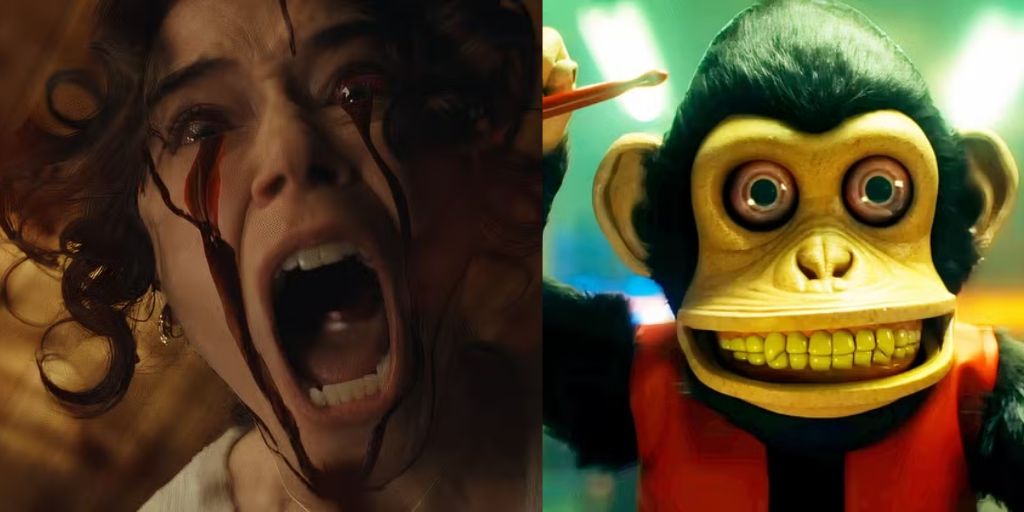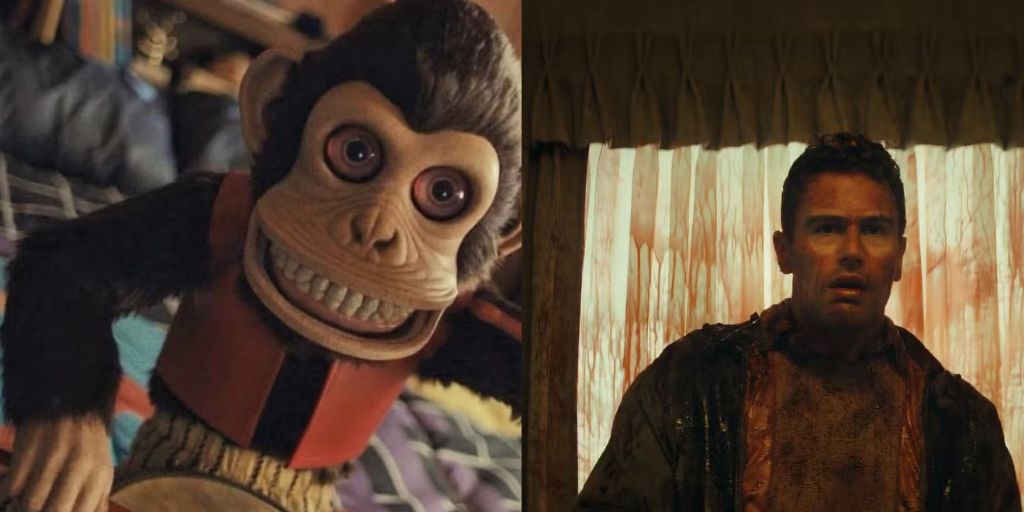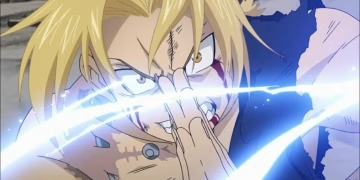Osgood Perkins creates stories that remind us how life does not care about human relationships. His characters often deal with suffering, whether it comes from supernatural forces, deep sorrow, or unfortunate events. They struggle to find happiness while misfortune surrounds them.
His new film, The Monkey, fully embraces this idea. It presents a world where pain and loss feel unavoidable, yet the film also finds humor in these dark moments. The movie balances horror with comedy and delivers an emotional core that makes it deeply engaging.
It is Perkins’ most entertaining work so far. He shows how hope can survive in a cruel world and does it in a way that feels both thrilling and meaningful. The ending of The Monkey perfectly represents this theme.
Also Read: ‘The Gorge’ Ending Explained: The Gorge Delivers Action and Mystery
A Sinister Toy Brings Disaster Wherever It Goes
Hal and Bill are identical twins who have faced hardship since childhood. Their father abandoned them, and their mother, struggling with alcohol, constantly complains about life’s unfairness.
With such an unstable home, the brothers only have each other for support. However, their bond is far from perfect. Bill often bullies Hal, forcing him to submit to his will.
One day, the twins go through their father’s belongings and find a mechanical toy monkey. This toy has a deadly power—it causes horrifying deaths when someone turns its key. The monkey never physically harms anyone, but it influences reality to create gruesome accidents. For example, when a chef in a teppanyaki restaurant uses a knife, the monkey ensures that the blade slashes a diner’s throat.
Hal, fed up with Bill’s abuse, decides to use the monkey against him. However, instead of killing Bill, the monkey takes their mother’s life. This tragic event breaks their bond forever.
Hal, terrified of the monkey’s power, tries to destroy it, but the toy always returns in perfect condition. Desperate to get rid of it, the twins seal it in a box and throw it down a well. After that, they go their separate ways, leaving their childhood behind.
Hal Becomes a Broken Man Haunted by His Past
Years pass, and Hal becomes a lonely man, avoiding close relationships out of fear that the monkey might return. He works at a small convenience store, living a dull and isolated life. His relationship with his son, Petey, is falling apart. Hal’s ex-wife is now with a man named Ted, who pretends to be a self-improvement expert. If Hal does not change, he will lose his parental rights, making this his last chance to be a good father.
Hal struggles with an internal conflict. He does not want to abandon his son, yet he feels trapped in the same cycle as his father. He saw how desperate his dad was to escape the monkey, and now he is going through the same ordeal. Petey does not understand Hal’s fears.
He only sees a distant and unreliable father. The monkey serves as a metaphor for life’s cruelty, and Perkins continues his exploration of how parents, despite their best intentions, can still harm their children.
Meanwhile, a rebellious teenager named Thrasher stumbles upon the monkey at a garage sale. Without knowing its dark history, he turns the key. The toy immediately causes the brutal death of Hal’s aunt, Ida. The cycle of horror begins again, pulling Hal and Petey into its grip.
A Twisted Reunion Between the Estranged Twins
Hal receives an unexpected call from his long-lost brother, Bill. Bill tells Hal that the monkey has returned and urges him to find it before it causes more destruction.
Hal quickly believes him but questions why Bill cannot retrieve the toy himself. Before answering, Bill abruptly hangs up. His behavior seems suspicious, hinting at a hidden agenda.
As Hal investigates, the truth becomes clear—Bill is responsible for the monkey’s return. He never forgave Hal for their mother’s death and spent years living with anger and pain. In his twisted logic, he convinces himself that the monkey represents justice. He retrieves it from the well and sets it loose, hoping it will seek out Hal and punish him.
Bill’s obsession with revenge transforms him. He believes he can control the monkey and use it for his own benefit. When Hal and Petey track him down, they discover Bill’s growing belief that the monkey never harms the person who turns the key. This dangerous idea leads him to suggest an awful plan—he wants Petey to turn the key, believing it will ensure his safety.

Hal refuses, trying to talk sense into his brother. He urges Bill to let go of the past, but Bill is too consumed by his own hatred. For the first time, Bill hesitates, touched by Hal’s sincere plea. Just as they seem to reconcile, the monkey strikes. Bill’s elaborate security trap, designed to kill intruders, backfires. A cannonball smashes into Bill’s head, instantly killing him in a shocking and darkly humorous moment.
A Grim Yet Hopeful Ending
With Bill gone, Hal decides to take responsibility for the monkey. He understands that its power cannot be controlled, so he vows to keep it locked away forever. Shaken but emotionally reconnected, Hal and Petey leave, witnessing the aftermath of Bill’s reckless actions.
The destruction is horrifying—burning baby carriages, impaled victims, and shattered lives. Bill, obsessed with using the monkey against Hal, unknowingly causes massive devastation. His selfishness destroyed innocent lives, highlighting how unchecked anger and revenge led to ruin.
As Hal and Petey drive away, they see a mysterious old woman in dark, tattered clothes riding a horse. This vision has haunted Hal throughout the film. It remains unclear whether she is real or a supernatural trick played by the monkey. The eerie moment leaves the audience unsettled, reinforcing the idea that life’s mysteries are often beyond human understanding.
Despite the horror they have witnessed, Hal and Petey share a small but significant moment of connection. Hal suggests visiting a public attraction, and to his surprise, Petey agrees. This simple decision symbolizes a step toward healing. As they drive off, chaos continues—a bus full of cheerleaders is hit by a truck, creating another gruesome disaster.
The film ends on this note, reinforcing its central message. The monkey represents life itself—cruel, random, and without explanation. Yet, even in the darkest times, there is still a reason to move forward.
Also Read: ‘Dexter: Original Sin’ Ending Explained: Delivers Suspense, Shocking Twists, and Emotional Showdowns





